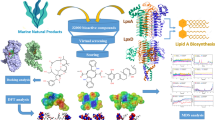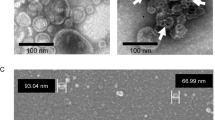Abstract
Antimicrobial peptides (AMPs) have gained interesting as a new type of antimicrobial agent. The cathelicidin-derived antimicrobial peptide PMAP-23 has broad-spectrum antibacterial activity, and to improve its antimicrobial activity, we used amino acid substitution at position 5 or 19 of PMAP-23 to design three analogs, named PMAP-23R (Leu5--Arg), PMAP-23I (Thr19--Ile), and PMAP-23RI (Leu5--Arg and Thr19--Ile). We found that the analog peptides exhibited higher stability and improved antibacterial activity compared with PMAP-23. Additionally, the analog peptides PMAP-23I and PMAP-23RI inhibited the growth of Shigella flexneri CICC 21534, whereas PMAP-23 and PMAP-23R exhibited no antibacterial activity against S. flexneri CICC 21534. Moreover, the peptide analogs showed negligible hemolysis and cytotoxicity. We also found that PMAP-23RI exerted impressive therapeutic effects on mice infected with Staphylococcus aureus ATCC 25923 and Salmonella enterica serovar Typhimurium SL1344. PMAP-23RI induced a greater reduction in pathological damage and a higher decrease in the bacterial gene copies in the lung and liver tissues and greatly reduced mouse mortality. In conclusion, the peptide analogs PMAP-23R, PMAP-23I, and PMAP-23RI enhanced the stability and antimicrobial activity of PMAP-23, but PMAP-23RI exhibits more promise as a new antimicrobial agent candidate for the treatment of bacterial infections.










Similar content being viewed by others
References
Izadpanah A, Gallo RL (2005) Antimicrobial peptides. J Am Acad Dermatol 52:381–390. https://doi.org/10.1016/j.jaad.2004.08.026
Haney EF, Mansour SC, Hancock REW (2017) Antimicrobial peptides: an introduction. In: Hansen P (ed) Antimicrobial Peptides. Methods in Molecular Biology. Humana Press, New York, pp 3–22
Lee JK, Park SC, Hahm KS, Park Y (2013) Antimicrobial HPA3NT3 peptide analogs: placement of aromatic rings and positive charges are key determinants for cell selectivity and mechanism of action. Biochim Biophys Acta 1828:443–454. https://doi.org/10.1016/j.bbamem.2012.09.005
Almatar M, Makky EA, Yakıcı G, Var I, Kayar B, Köksal F (2018) Antimicrobial peptides as an alternative to anti-tuberculosis drugs. Pharmacol Res 128:288–305. https://doi.org/10.1016/j.phrs.2017.10.011
Bastos P, Trindade F, da Costa J, Ferreira R, Vitorino R (2018) Human antimicrobial peptides in bodily fluids: current knowledge and therapeutic perspectives in the postantibiotic era. Med Res Rev 38:101–146. https://doi.org/10.1002/med.21435
Nuti R, Goud NS, Saraswati AP, Alvala R, Alvala M (2017) Antimicrobial peptides: a promising therapeutic strategy in tackling antimicrobial resistance. Curr Med Chem 24:4303–4314. https://doi.org/10.2174/0929867324666170815102441
Torres MDT, Sothiselvam S, Lu TK, de la Fuente-Nunez C (2019) Peptide design principles for antimicrobial applications. J Mol Biol 431:3547–3567. https://doi.org/10.1016/j.jmb.2018.12.015
Zanetti M, Storici P, Tossi A, Scocchi M, Gennaro R (1994) Molecular cloning and chemical synthesis of a novel antibacterial peptide derived from pig myeloid cells. J Biol Chem 269:7855–7858. https://doi.org/10.1111/j.1467-8268.2006.00147.x
Shin SY, Kang JH, Jang SY, Kim KL, Hahm KS (2000) Structure and antibiotic activity of a porcine myeloid antibacterial peptide, PMAP-23 and its analogues. J Biochem Mol Biol 33:49–53
Veldhuizen EJA, Scheenstra MR, Tjeerdsma-van Bokhoven JLM, Coorens M, Schneider VAF, Bikker FJ, Avan D, Haagsman HP (2017) Antimicrobial and immunomodulatory activity of PMAP-23 derived peptides. Protein Pept Lett 24:609–616. https://doi.org/10.2174/0929866524666170428150925
Bauer AW, Kirby WM, Sherris JC, Turck M (1966) Antibiotic susceptibility testing by a standardized single disk method. Tech Bull Regist Med Technol 36:49–52. https://doi.org/10.1093/ajcp/45.4_ts.493
Zhou JF, Liu YQ, Shen TF, Chen LL, Zhang C, Cai KR, Liu ZX, Meng XM, Zhang L, Liao CS, Wang C (2019) Enhancing the antibacterial activity of PMAP-37 by increasing its hydrophobicity. Chem Biol Drug Des 94:1986–1999. https://doi.org/10.1111/cbdd.13601
Zhong C, Zhu NY, Zhu YW, Liu TQ, Gou SH, Xie JQ, Yao J, Ni JM (2020) Antimicrobial peptides conjugated with fatty acids on the side chain of D-amino acid promises antimicrobial potency against multidrug-resistant bacteria. Eur J Pharm Sci 141:105123. https://doi.org/10.1016/j.ejps.2019.105123
Wang M, Lin J, Sun Q, Zheng K, Ma Y, Wang J (2019) Design, expression, and characterization of a novel cecropin A-derived peptide with high antibacterial activity. Appl Microbiol Biotechnol 103:1765–1775. https://doi.org/10.1007/s00253-018-09592-z
Hong W, Gao X, Qiu P, Yang J, Qiao MX, Shi H, Zhang DX, Tian CL, Niu SL, Liu MC (2017) Synthesis, construction, and evaluation of self-assembled nano-bacitracin A as an efficient antibacterial agent in vitro and in vivo. Int J Nanomedicine 12:4691–4708. https://doi.org/10.2147/IJN.S136998
Oddo A, Hansen PR (2017) Hemolytic activity of antimicrobial peptides. In: Hansen P (ed) Antimicrobial Peptides. Methods in Molecular Biology. Humana Press, New York, pp 427–435
Jia F, Zhang Y, Wang J, Peng J, Zhao P, Zhang L, Yao H, Ni J, Wang K (2019) The effect of halogenation on the antimicrobial activity, antibiofilm activity, cytotoxicity and proteolytic stability of the antimicrobial peptide Jelleine-I. Peptides 112:56–66. https://doi.org/10.1016/j.peptides.2018.11.006
Jiang W, Jiang P, Li Y, Tang J, Wang X, Ma S (2006) Recombinant adenovirus expressing GP5 and M fusion proteins of porcine reproductive and respiratory syndrome virus induce both humoral and cell-mediated immune responses in mice. Vet Immunol Immunopathol 113:169–180. https://doi.org/10.1016/j.vetimm.2006.05.001
Zhou JF, Zhang C, Liu ZX, Liu YQ, Cai KR, Shen TF, Liao CS, Wang C (2018) Adjuvant activity of bursal pentapeptide-(III-V) in mice immunized with the H9N2 avian influenza vaccine. Protein Pept Lett 25:757–766. https://doi.org/10.2174/0929866525666180806110928
Wang X, Fu W, Yuan S, Yang X, Song Y, Liu L, Chi Y, Cheng T, Xing M, Zhang Y (2017) Both haemagglutinin-specific antibody and T cell responses induced by a chimpanzee adenoviral vaccine confer protection against influenza H7N9 viral challenge. Sci Rep 7:1854. https://doi.org/10.1038/s41598-017-02019-1
Yang ST, Jeon JH, Kim Y, Shin SY, Hahm KS, Kim JI (2006) Possible role of a PXXP central hinge in the antibacterial activity and membrane interaction of PMAP-23, a member of cathelicidin family. Biochemistry 45:1775–1784. https://doi.org/10.1021/bi051524k
Ferreira A, Bolland MJ, Thomas MG (2016) Meta-analysis of randomised trials comparing a penicillin or cephalosporin with a macrolide or lincosamide in the treatment of cellulitis or erysipelas. Infection 44:607–615. https://doi.org/10.1007/s15010-016-0895-x
Kardos N, Demain AL (2011) Penicillin: the medicine with the greatest impact on therapeutic outcomes. Appl Microbiol Biotechnol 92:677–687. https://doi.org/10.1007/s00253-011-3587-6
Peter R, Müntener C, Demuth D, Heim D, Stucki F, Mevissen M, Gerspach C, Kaske M, Steiner A, Meylan M (2018) AntibioticScout.ch: decision support for the prudent use of antimicrobials: application in cattle. Schweiz Arch Tierheilkd 160:219–226. https://doi.org/10.17236/sat00154
Cheng G, Hao H, Xie S, Wang X, Dai M, Huang L, Yuan Z (2014) Antibiotic alternatives: the substitution of antibiotics in animal husbandry? Front Microbiol 5:217. https://doi.org/10.3389/fmicb.2014.00217
Mwangi J, Yin YZ, Wang G, Yang M, Li Y, Zhang ZY, Lai R (2019) The antimicrobial peptide ZY4 combats multidrug-resistant Pseudomonas aeruginosa and Acinetobacter baumannii infection. Proc Natl Acad Sci U S A 116:26516–26522. https://doi.org/10.1073/pnas.1909585117
Carvalho Ade O, Gomes VM (2009) Plant defensins-prospects for the biological functions and biotechnological properties. Peptides 30:1007–1020. https://doi.org/10.1016/j.peptides.2009.01.018
Asthana N, Yadav SP, Ghosh JK (2004) Dissection of antibacterial and toxic activity of melittin: a leucine zipper motif plays a crucial role in determining its hemolytic activity but not antibacterial activity. J Biol Chem 279:55042–55050. https://doi.org/10.1074/jbc.M408881200
Wiradharma N, Sng MYS, Khan M, Ong ZY, Yang YY (2013) Rationally designed α-helical broad-spectrum antimicrobial peptides with idealized facial amphiphilicity. Macromol Rapid Commun 34:74–80. https://doi.org/10.1002/marc.201200534
Abou Alaiwa MH, Reznikov LR, Gansemer ND, Sheets KA, Horswill AR, Stoltz DA, Zabner J, Welsh MJ (2014) PH modulates the activity and synergism of the airway surface liquid antimicrobials β-defensin-3 and LL-37. Proc Natl Acad Sci U S A 111:18703–18708. https://doi.org/10.1073/pnas.1422091112
Andreev K, Martynowycz MW, Huang ML, Kuzmenko I, Bu W, Kirshenbaum K, Gidalevitz D (2018) Hydrophobic interactions modulate antimicrobial peptoid selectivity towards anionic lipid membranes. Biochim Biophys Acta Biomembr 1860:1414–1423. https://doi.org/10.1016/j.bbamem.2018.03.021
Criswell AR, Bae E, Stec B, Konisky J, Phillips GN Jr (2003) Structures of thermophilic and mesophilic adenylate kinases from the genus Methanococcus. J Mol Biol 330:1087–1099. https://doi.org/10.1016/S0022-2836(03)00655-7
Prell JS, O'Brien JT, Steill JD, Oomens J, Williams ER (2009) Structures of protonated dipeptides: the role of arginine in stabilizing salt bridges. J Am Chem Soc 131:11442–11449. https://doi.org/10.1021/ja901870d
Ausili A, Pennacchio A, Staiano M, Dattelbaum JD, Fessas D, Schiraldi A, D’Auria S (2013) Amino acid transport in thermophiles: characterization of an arginine-binding protein from Thermotoga maritima. 3. Conformational dynamics and stability. J Photochem Photobiol B 118:66–73. https://doi.org/10.1016/j.jphotobiol.2012.11.004
Morris SM (2009) Recent advances in arginine metabolism: roles and regulation of the arginases. Br J Pharmacol 157:922–930. https://doi.org/10.1111/j.1476-5381.2009.00278.x
Martin S, Desai K (2020) The effects of oral arginine on its metabolic pathways in Sprague Dawley rats. Br J Nutr 123:135–148. https://doi.org/10.1017/S0007114519002691
Santajit S, Indrawattana N (2016) Mechanisms of antimicrobial resistance in ESKAPE pathogens. Biomed Res Int 2016:2475067–2475068. https://doi.org/10.1155/2016/2475067
Tsolis RM, Adams LG, Ficht TA, Bäumler AJ (1999) Contribution of Salmonella typhimurium virulence factors to diarrheal disease in calves. Infect Immun 67:4879–4885. https://doi.org/10.1111/j.1574-695X.1999.tb01365.x
Zhang R, Wu F, Wu L, Tian Y, Zhou B, Zhang X, Huang R, Yu C, He G, Yang L (2018) Novel self-assembled micelles based on cholesterol-modified antimicrobial peptide (DP7) for safe and effective systemic administration in animal models of bacterial infection. Antimicrob Agents Chemother 62:e00368–e00318. https://doi.org/10.1128/AAC.00368-18
Bowdish DM, Davidson DJ, Lau YE, Lee K, Scott MG, Hancock RE (2005) Impact of LL-37 on anti-infective immunity. J Leukoc Biol 77:451–459. https://doi.org/10.1189/jlb.0704380
Zanetti M (2005) The role of cathelicidins in the innate host defenses of mammals. Curr Issues Mol Biol 7:179–196. https://doi.org/10.1016/j.expneurol.2006.10.011
Orioni B, Bocchinfuso G, Kim JY, Palleschi A, Grande G, Bobone S, Park Y, Kim JI, Hahm KS, Stella L (2009) Membrane perturbation by the antimicrobial peptide PMAP-23: a fluorescence and molecular dynamics study. Biochim Biophys Acta 1788:1523–1533. https://doi.org/10.1016/j.bbamem.2009.04.013
Roversi D, Luca V, Aureli S, Park Y, Mangoni ML, Stella L (2014) How many antimicrobial peptide molecules kill a bacterium? The case of PMAP-23. ACS Chem Biol 9:2003–2007. https://doi.org/10.1021/cb500426r
Baumann A, Démoulins T, Python S, Summerfield A (2014) Porcine cathelicidins efficiently complex and deliver nucleic acids to plasmacytoid dendritic cells and can thereby mediate bacteria-induced IFN-α responses. J Immunol 193:364–371. https://doi.org/10.4049/jimmunol.1303219
Funding
This work was supported by the National Natural Science Foundation of China [31101792], the Natural Science Foundation of Henan Province [182300410030], and the Programs for Science and Technology Development of Henan Province [182102110208].
Author information
Authors and Affiliations
Corresponding author
Ethics declarations
Conflict of Interest
The authors declare that they have no conflicts of interest.
Ethical Approval
All procedures involving animals that were performed in this study were in accordance with the Animal Experiment Committee of Henan University of Science and Technology (No. 20180301001).
Additional information
Publisher’s Note
Springer Nature remains neutral with regard to jurisdictional claims in published maps and institutional affiliations.
Electronic Supplementary Material
ESM 1
(DOCX 843 kb)
Rights and permissions
About this article
Cite this article
Liu, Y., Shen, T., Chen, L. et al. Analogs of the Cathelicidin-Derived Antimicrobial Peptide PMAP-23 Exhibit Improved Stability and Antibacterial Activity. Probiotics & Antimicro. Prot. 13, 273–286 (2021). https://doi.org/10.1007/s12602-020-09686-z
Published:
Issue Date:
DOI: https://doi.org/10.1007/s12602-020-09686-z




